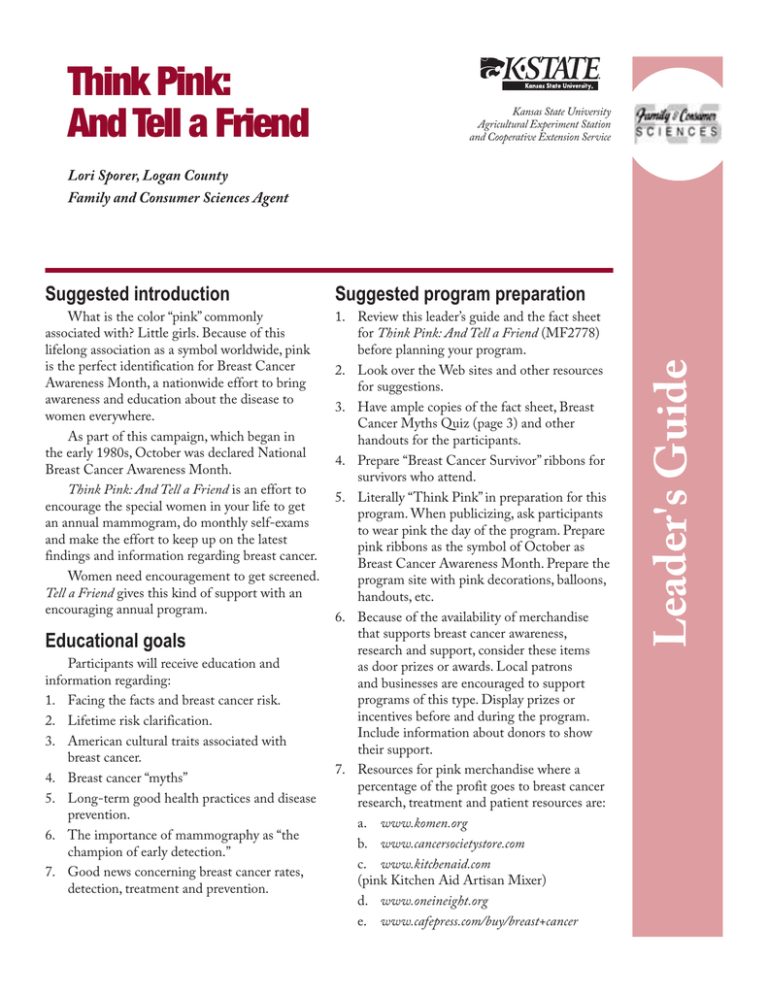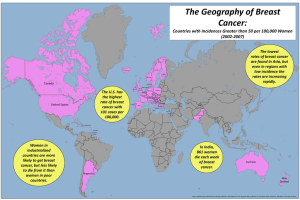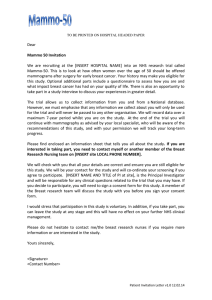
Think Pink:
And Tell a Friend
Kansas State University
Agricultural Experiment Station
and Cooperative Extension Service
Suggested introduction
Suggested program preparation
What is the color “pink” commonly
associated with? Little girls. Because of this
lifelong association as a symbol worldwide, pink
is the perfect identification for Breast Cancer
Awareness Month, a nationwide effort to bring
awareness and education about the disease to
women everywhere.
As part of this campaign, which began in
the early 1980s, October was declared National
Breast Cancer Awareness Month.
Think Pink: And Tell a Friend is an effort to
encourage the special women in your life to get
an annual mammogram, do monthly self-exams
and make the effort to keep up on the latest
findings and information regarding breast cancer.
Women need encouragement to get screened.
Tell a Friend gives this kind of support with an
encouraging annual program.
1. Review this leader’s guide and the fact sheet
for Think Pink: And Tell a Friend (MF2778)
before planning your program.
2. Look over the Web sites and other resources
for suggestions.
3. Have ample copies of the fact sheet, Breast
Cancer Myths Quiz (page 3) and other
handouts for the participants.
4. Prepare “Breast Cancer Survivor” ribbons for
survivors who attend.
5. Literally “Think Pink” in preparation for this
program. When publicizing, ask participants
to wear pink the day of the program. Prepare
pink ribbons as the symbol of October as
Breast Cancer Awareness Month. Prepare the
program site with pink decorations, balloons,
handouts, etc.
6. Because of the availability of merchandise
that supports breast cancer awareness,
research and support, consider these items
as door prizes or awards. Local patrons
and businesses are encouraged to support
programs of this type. Display prizes or
incentives before and during the program.
Include information about donors to show
their support.
7. Resources for pink merchandise where a
percentage of the profit goes to breast cancer
research, treatment and patient resources are:
a. www.komen.org
b. www.cancersocietystore.com
c. www.kitchenaid.com
(pink Kitchen Aid Artisan Mixer)
d. www.oneineight.org
e. www.cafepress.com/buy/breast+cancer
Educational goals
Participants will receive education and
information regarding:
1. Facing the facts and breast cancer risk.
2. Lifetime risk clarification.
3. American cultural traits associated with
breast cancer.
4. Breast cancer “myths”
5. Long-term good health practices and disease
prevention.
6. The importance of mammography as “the
champion of early detection.”
7. Good news concerning breast cancer rates,
detection, treatment and prevention.
Leader's Guide
Lori Sporer, Logan County
Family and Consumer Sciences Agent
Suggested teaching activities
1. Have participants work on the “Breast
Cancer Myths: True or False” worksheet
(page 3) as they arrive.
2. Have an “information table” set up with
brochures from the American Cancer Society
and any other resources regarding questions,
resources, examination guides, support and
post-treatment.
3. Have breast lump “models” available for
participants to practice on to see if they can
find the lumps in the models to aid in their
own self exams. These are available through
most county health departments or the
county health nurse.
4. “Tell a Friend” Pledge: At the conclusion
of your program, request all participants to
stand and hold hands while they repeat the
pledge after you, reading one line at a time
for them to repeat. It is also a great idea to
have the pledge printed on pink paper or
cardstock, so they can pass it onto a friend
who did not attend.
Answers to “Breast Cancer Myths: True or
False” Quiz (page 3)
1. False. According to the American Cancer
Society, 75 percent of all breast cancer
diagnoses are in women 50 years of age or
older, but 9,000 women 40 and younger were
diagnosed in 2000. The younger the age at
diagnosis, the more aggressive the cancer has
historically proven to be.
2. False. Hereditary breast cancer counts for only
10 percent of cases. In 90 percent of all other
cases, the cells became cancerous spontaneously.
3. True … but you’re still at risk. With latein-life breast cancer, genetic connections are
reduced.
4. True. The 1992 Mammography Quality
Standards Act states that all U.S. facilities
must be certified by the FDA. To become
certified, they must produce clear films,
use low level-radiation equipment, read a
minimum of 480 mammograms a year and
keep current in required continuing education.
5. False. By the time a lump can be felt in
a self-exam, it can be 8 to 10 years old.
Mammography detects cancerous lumps
much earlier in their existence.
6. False. According to the American Cancer
Society, 80 percent of all lumps are benign.
Even though your doctor is confident that
your lump is a cyst, a fibroid or premenstrual
lump, if you are concerned don't be reluctant
to press for testing to rule out cancer.
7. False. Waiting for test results is stressful. Ask
specific questions in advance. “I’m concerned,
and would feel better if we set up a time for
a phone call in advance.” Delays are often
legitimate … but your peace of mind and
health are at stake, and you are responsible
for those two items.
8. True. The survival rate is now 96 percent
with an early diagnosis and after five years of
remission.
9. False. Cysts are common and rarely turn into
cancer. The important component is finding
out conclusively that the lump is, in fact, a cyst.
10. False. There is more good news than bad
regarding a breast cancer diagnosis. With the
ever-increasing survival rates, treatments with
fewer side effects, improved diagnostic abilities,
the ability to diagnose at early stages, a diagnosis
of breast cancer is not a death sentence.
Breast cancer myths: True or False
1.__You’re too young to have breast cancer.
2.__You don’t have a family history of breast
cancer, so your risk is low.
3. __If your mother had breast cancer after she
went through menopause, it slightly decreases
your risk.
4.__ Mammography facilities are regulated by
the FDA. Technicians must be certified and
participate in regular continuing education.
5.__ If you do monthly breast self-exams, you
don’t need a mammogram.
6.__ “Your lump is nothing to worry about. Let’s
watch it for a few months and wait to see
what it does.”
7.__ You have no reason to worry. “Don’t call
us…we’ll call you.” “We’ll have the results
‘sometime’ at the end of the week.”
8 __ A breast cancer diagnosis is not a death
sentence.
9.__ Breast cysts lead to malignant cancers.
10.__ There is no “good news” when it comes to
breast cancer.
The ‘Tell a Friend’ Pledge
Today I pledge to my dear friends,
to those I love, and in whom I depend.
Today I pledge a monthly check,
for changes that she might suspect.
Today I pledge an open door,
when questions arise with the ones I adore.
Today I pledge my support to offer,
the encouragement she needs to visit her doctor.
Today I pledge to my dear friends,
to those I love, and in whom I depend.
Author:
Lori Sporer, Logan County Family Consumer Sciences Agent
Reviewed by:
Paula Peters, Ph.D., Assistant Director, Extension Family and Consumer Sciences
Georgetta Schoenfeld, R.N., Director, Logan County Health Department
Brand names appearing in this publication are for product identification purposes only.
No endorsement is intended, nor is criticism implied of similar products not mentioned.
Publications from Kansas State University are available on the World Wide Web at: www.oznet.ksu.edu
Publications from Kansas State University may be freely reproduced for educational purposes.
All other rights reserved. In either case, credit Lori Sporer, Think Pink: And Tell a Friend, Leader's Guide,
Kansas State University, July 2007.
Kansas State University Agricultural Experiment Station and Cooperative Extension Service, Manhattan, Kansas
MF2779
August 2007
K-State Research and Extension is an equal opportunity provider and employer. These materials may be available in alternative formats. Issued in furtherance of Cooperative
Extension Work, Acts of May 8 and June 30, 1914, as amended. Kansas State University, County Extension Councils, Extension Districts, and United States Department of Agriculture
Cooperating, Fred A. Cholick, Director.






